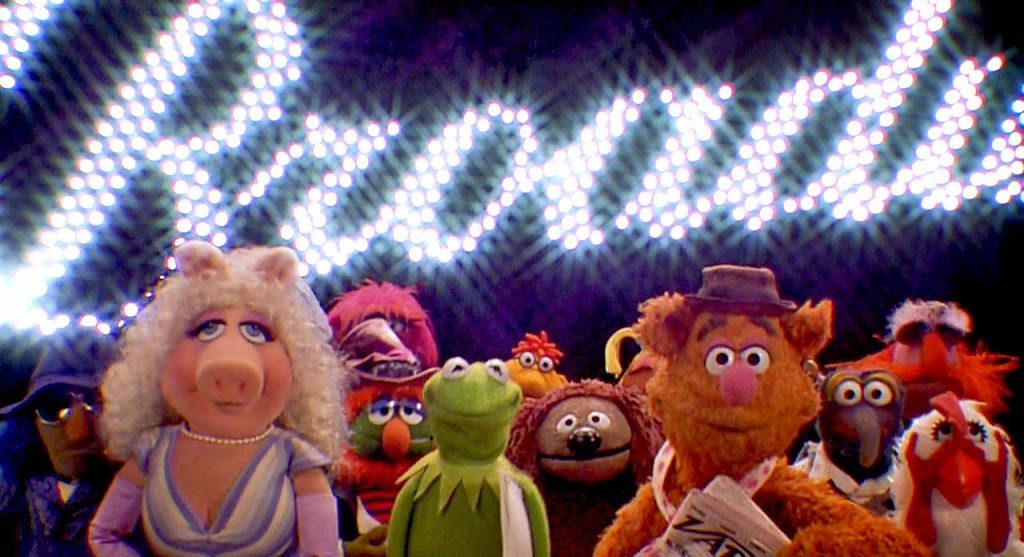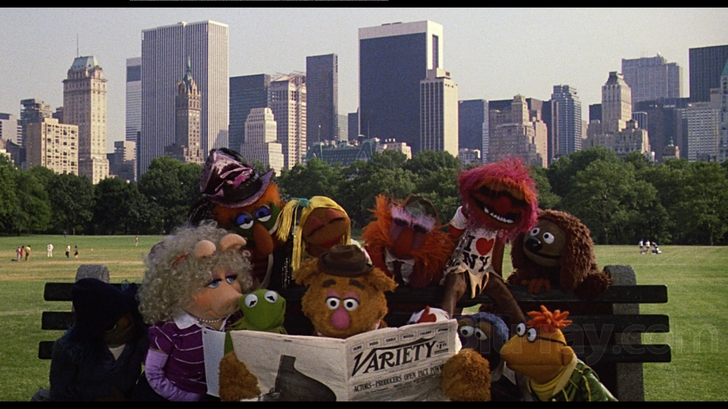Part of my ‘New York State of Mind’ series.
It’s a wonderful street for babes like us to be on,
we're here because we want out names in neon.
—‘Babes on Broadway’, Babes on Broadway, Burton Lane/E.Y. ‘Yip’ Harburg
Since he first appeared on screen in 1955, Kermit the Frog has had a prolific career. Discovered playing banjo in the swamp, Kermit (created and voiced by Jim Henson) has been a reporter on Sesame Street, the long-suffering MC and stage manager of the Muppet Theatre, the producer of Muppets Tonight and had his image co-opted as the face of Doc Hopper’s Frog Legs.
In The Muppets Take Manhattan he decides to scale the Mount Rushmore of American theatre, Broadway, and finds the second hardest thing after being green: breaking into show business.
The Muppets’ first big screen outing was The Muppet Movie, in which Kermit drove cross-country with Fozzie (voiced by Frank Oz) in “a bear’s natural habitat”, a Studebaker, befriending Miss Piggy (also Oz), Gonzo (Dave Goelz) et al. before arriving in California and being rewarded with a “standard rich and famous contract”, bestowed by none other than Orson Welles.
The Muppets Take Manhattan begins again with a new origin story. It’s the early eighties and Kermit and company are bright, eager members of the graduating class of Danhurst College and starring in their very own musical revue, Manhattan Melodies. When a patron shouts that he’ll see Kermit on Broadway, that’s all the prompting Scooter (Richard Hunt) needs to convince the rest of the gang to take their show to the Great White Way.
The Muppets move to New York and do their best to acclimatise. Accommodation is surprisingly accessible: the lockers at the bus station are cramped, but at least they’re convenient. Finding a producer is tougher. The Muppets are unknowns pitching a show they’ve written and intend to star in themselves, a sunny musical with nary a trace of edginess—their enthusiasm is bound to outstrip interest. One pitch session seems promising, until the ‘producer’ is unmasked as a con man and the film treats us to the sight of a grown man staggering down a corridor with a chicken in one hand, Gonzo in the other and Animal (Oz) clinging to his trouser leg. Two workmen watch them go by without comment—a quintessentially New York moment.
After months of beating the pavement, the Muppets are forced to admit defeat. They go their separate ways and put their dream on hold—all except Kermit, who refuses to give up.

From its spangled stage numbers to its shiny optimism, The Muppets Take Manhattan is a loving homage to Mickey Rooney and Judy Garland’s ‘Backyard Musicals’. Hey kids, let’s put on a show! You write the music, I’ll write the lyrics and the costumes and choreography will take care of themselves. Despite its many joys, The Great Muppet Caper had been a box office disappointment. Henson decided the Muppets needed something different and handed the director’s chair over to Oz, who also co-wrote Manhattan’s screenplay with Tom Patchett and Jay Tarses. The film hits all the expected beats, but does so with sweetness and charm. Unlike The Muppet Movie and The Great Muppet Caper, there’s no villain, unless you count the indifference of a city that isn’t always kind to dreams.
The human performers also take a back seat to the Muppets, mostly appearing in cameos, including Joan Rivers as Miss Piggy’s partner in misery at a makeup counter and Gregory Hines as a jogger who finds himself arbitrating between Kermit and Piggy in Central Park.
Part of the Muppets’ appeal is that they are always essentially themselves. Plots and formats may change but the Muppets remain the same: Gonzo is a commuter from cloud cuckoo land; Animal is an animal; and Miss Piggy will do anything for love of her frog. Piggy is as fierce as ever but Manhattan also shows her gentler side. A cute sequence has her imagining what it would have been like if she and Kermit had met as toddlers. The number was so popular it spawned a spin-off: Muppet Babies. As for Kermit, his schemes to get the show made (one requires him to wear an afro!) raise a few chuckles, but none of them resonate half as much as the sight of him shouting defiantly from the top of the Empire State Building, “The frog is staying!”
A paean to optimism, The Muppets Take Manhattan is also inextricably linked with melancholy. It was the last Muppet film Jim Henson made before his death at just 53. Like Kermit, the Muppet who became his alter ego, Henson inspired his fellow performers with his imagination, creativity and hope. The Muppets Take Manhattan is a fitting tribute, part of the legacy he left for lovers, dreamers and us.

I used to love The Muppet Show when I was younger. Of course I did not watch all the episodes but little me was fascinated with the characters. I did not see this film though.